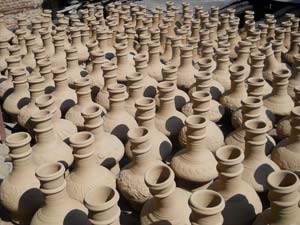Not long back, kitchens in households across Kashmir were filled with utensils made up of clay. With the advent of modernity, new trends emerged. Clay-made pots and plates were replaced by copper, porcelain and bone-china which is slowly paving way for the death of the man’s ancient art of pottery, Junaid Nabi Bazaz reports.
Sitting outside his shop on the banks of Dal Lake in Srinagar, Abdul Gani Kumar haggles with his customer on the price of clay-made items on a daily basis. “I work hard to produce these items. It is my right to earn some profit,” says Kumar, who has been working as a potter since early 1960s.
“But if you will not give me a concession, I would not buy it. I will buy a plastic box which costs half than the clay-made box,” an unconvinced customer shots back at Kumar. Out of the fear of losing a customer, Kumar sells the box at a low cost. “This is not new to us. We face situations like these dozens of times a day,” Kumar told Kashmir Life.
Before the migration of Pandits, a large number of earthen items were sold by the potters of Kashmir valley to them. Using clay-made items is considered sacred to Hinduism. “Using clay-made items is considered an act of sanctity since earth represents our deities like other elements of nature including fire and water,” said Ashok Pawan, a Kashmiri Pandit.
With the migration of Pandits, the potters of Kashmir lost a large customer base but they didn’t lose hope. They tried to bring in innovations to the art like using attractive colours and creating new designs. “Modernity has brought changes. There are items made in plastic, steel and aluminium now with which our earthen ware has to compete. We try to make new items to suit the changes in the market and somehow, some people still prefer our clay pots” said Kumar.
Tumbaknaer (earthen drum used in marriages), foot scrubber, flower pots, small pots and piggy banks are some of the items which are still purchased by people in Kashmir valley from the potters even today.
But Kumar is unhappy with the system and says that the state government has not done anything to protect their craft. “I met several ministers in my life to discuss our grievances. I recently met chief minister, Omar Abdullah who did not pay any attention to me. He told me to talk to his advisors.”
The meeting with CM’s advisors, Kumar says, crashed his hopes. He described the tale of his ignored art to them but it was of no use. Nothing conclusive so far has happened Kumar claims.
Kumar inherited the art of pottery from his father when he left the government job in the state’s irrigation department. When Kumar felt that he could not earn a decent living, he decided not to engage his children in his work. “My father left me some land which was not sufficient to carry out this laborious work. I could not save any money because I live hand to mouth. Hence I could not extend it. That is why I asked my children to pursue other professions. How can I force my love for the craft on them?” says Kumar with a strange-looking face. Many potters whose shops surround Kumar’s turned down requests to share their experiences. “I am fed up of it. This art is lost. I always think of leaving it,” one of them shouted.
Jammu and Kashmir’s noted poet and social activist, Zareef Ahmad Zareef, says Kashmiris were used to pottery items, “Utensils made of clay were commonly used. But nowadays, the culture of Kashmir has changed. In the past, parents passed this profession to their children. But now, nothing of that sort is happening. The present generation is not ready to take up pottery as a profession. Either they feel ashamed as potters or they are insecure with the meagre income the art fetches. These are the main reasons that this art is dying.”
Whatever the reasons, Kashmir is gradually losing this art and there is hardly any way or means to revive the lost tradition, like many of our dying traditions! Even the state’s census department has no statistics of potters available with it. The data with the department is classified into two groups: workers and non-workers. “I can only tell you about the number of workers or non-workers. We don’t have any particular statistics about the number of potters in the state,” joint director of census department, CS Sapru, told Kashmir Life.
















